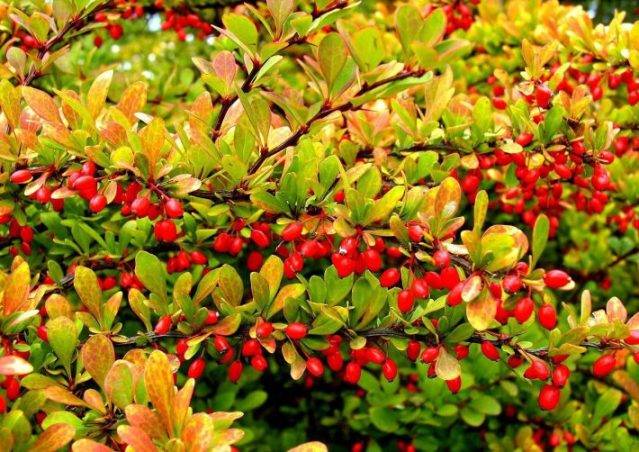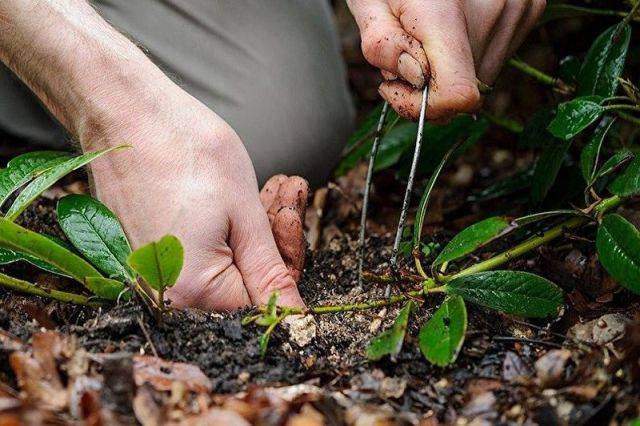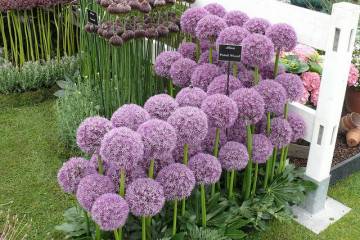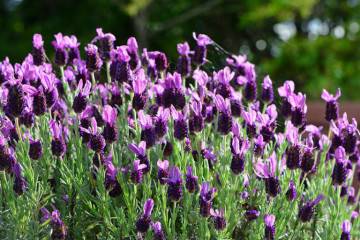Barberry - planting and care in the open field
Content:
The family of the barberry bush is rich and varied. The most common type is common barberry. The plant is distinguished by its useful properties and decorative properties. In nature, it is found not only on the plateau, but also grows successfully in mountainous areas.
Description of barberry: popular varieties and types
There are many varieties of barberry and each has its own unique characteristics. Gardeners choose varieties based on preference.
Some popular varieties are presented below.
Common barberry
The Latin name for this variety: (Latin Berberis vulgaris).
This is a thorny perennial shrub 2-3 m in height. The brown trunk and shoots have sharp thorns. The leaves are elliptical, 4.5 by 2.5 cm in size. The bushiness of the plant is high. Arcuate shoots, medium length. The shrub is fed by a highly developed root system with creeping roots located in the upper layer of the soil.
In autumn, the green leaves of the barberry take on a burgundy, purple or fiery color. Blooms in spring for 2 weeks. The flowers are small, yellow in color.
The fruits are scarlet, sour and tart. The length of each berry is 2 cm, weight is up to 4 grams. The fruits are good for consumption.
Grown in southern and central Europe, in the North Caucasus.
Barberry Thunberg
Grows in Japan and China. The height of the bush is 1.5 m. The leaves in spring and summer are yellow or bright red, and in autumn they turn brown.
The flowers are usually yellow with a red border around the edges. Blooms for 8-12 days. The bitter-tasting fruits are not used for food. The shrub is not afraid of drought and cold, undemanding to the soil.
Amur barberry
A less popular variety. The height of the bushes is 3.5 m.
It tolerates drought well, but freezes in extreme cold. The foliage is green in summer, the bushes are red-leaved in the fall. Blooms in late May.
Planting site, soil
Barberry is planted in open ground in autumn or spring. The procedure is performed in the evening. How quickly the barberry grows depends on the observance of the planting rules and the choice of the place.
When landing, the following conditions are adhered to:
- in the selected area, the deep occurrence of groundwater;
- watering only during dry periods;
- lack of shadow;
- a calm place protected by buildings, outbuildings, a fence;
- loose fertile soil or loam;
- soil acidity pH 4–8.
Better to plant barberry in the fall. In this case, the bushes have time to take root. But if the desired option came across in the spring, it is advisable to purchase it with an earthen lump.
Planting barberry in open ground
For a seedling, a deep hole is chosen, since drainage, an earthen lump, and soil are placed there. And you also need a wide space to straighten the roots. When planting several plants, prepare a trench.
Drainage is located at the bottom. This is a layer of pebbles, gravel or broken brick. A soil mixture is poured over it. It is bought in the store.Or garden soil with mineral fertilizers is taken. This is followed by abundant watering.
After watering, a seedling is carefully placed in the hole. The roots are carefully straightened. In the presence of an earthen coma, it is not required to straighten the roots.
The hole is filled with the rest of the soil and tamped with your hands so that the root collar is at a depth of 3-4 cm.
This is followed by abundant watering and mulching of the trunk circle. Sawdust or fallen leaves are used.
Growing from seeds
Growing barberry from seeds is a long task, but a real one. Since the culture has seeds with a hard shell, stratification is carried out for 2–5 months at a temperature of 5 ° C. Peat or sand is used.
Seeds sown in the fall are stratified in the ground. Seedlings are left in the same place for 2 years, then transferred to a permanent place.
Watering and loosening the soil
Barberry is a plant that is not difficult to care for and does not take much time. The culture does not allow waterlogging. Therefore, adult bushes are watered no more than once every 2 weeks.
With regular precipitation, additional irrigation is not carried out. Juveniles need proper constant watering until they fully take root.
After watering, the soil is loosened, opening the way for oxygen to the root system. Remove weeds so that they do not absorb essential nutrients and do not carry infections and rot. Then the soil is mulched.
Breeding methods for barberry
There are several ways to propagate shrubs in the garden or in the country. These include cuttings, dividing the bush, grafting, seeds, root cuttings, self-seeding. Choose the most suitable one. A problem-free planting method is cuttings.
How to plant barberry cuttings:
- Cuttings are harvested during spring pruning. Lignified shoots are cut off.
- The place of the cut is dipped in Kornevin or Heteroauxin. Then they are placed in containers with wet sand.
- The cups are covered with a greenhouse and left in the garden. The shelter saves from a possible cold snap and maintains humidity.
- After the roots appear, the cuttings are transferred to the nutrient soil.
For rapid reproduction, methods such as dividing bushes or layering are chosen.
Top dressing and transplanting
How to care for barberry after it has adapted to the soil. Already from the second year of life, the bush is fed 2 times a year. The spring treatment includes fertilizers rich in nitrogen and potassium. To do this, use 20-30 g of urea per bucket of water. In autumn, the plant needs phosphorus.
When planting and caring for common barberry, one should not forget about its transplant. The procedure is performed every 10-15 years. During this time, the earth is depleted and its complete replacement is required.
The time for transplant is late summer, early autumn. Before transplanting, the plant is well pruned and watered. For removal from the soil, use a pitchfork.
The bushes, together with an earthen lump, are transferred to a new place on a film or tarpaulin. The size of the planting pit corresponds to the size of the earthen ball.
After transplanting, abundant watering and mulching are carried out.
Pruning barberry
The shrub is pruned in early spring or late autumn. For a plant, the procedure is painless. Before leaving for the winter, sanitary pruning frees the plant from dry, outdated, diseased branches.
And to maintain shape, a cosmetic haircut is done as the shoots grow back. But in any case, at least 4 buds must be left on the branches for subsequent vegetation.
Flowering period and care after
This shrub begins to bloom in May-July, it all depends on the variety, temperature conditions. The period lasts about 3 weeks. At this time, a wonderful smell emanates from the bush.
When the common barberry blooms, it attracts a large number of pollinating insects. Bees fly in, collecting nectar, pollen from flowers and leaves. In bloom - barberry is the best honey plant for bees.
During the flowering and fruiting seasons, pruning is carried out 2 times. Old branches are removed, taking away nutrients from the bush. They also cut off those that have begun to dry out or do not bloom at all and do not bear healthy fruits.
How to prepare for wintering
Prepare carefully for winter. They start from the area around the plantings. What to do in the fall:
- remove garbage;
- dig up the soil;
- make top dressing using compost;
- perform sanitary pruning;
- mulch the trunk circle with loose peat.
Young growth is covered with spruce branches until winter cold. The bush is tied with a rope, a box is made around it, dry leaves are placed in it. Then the box is wrapped with agrofiber.
Pests and diseases
Barberry bushes rarely infect insects, diseases overtake. But the appearance of aphids, powdery mildew and flower moth is not excluded. At the first symptoms, action should be taken immediately.
What are the signs of disease:
- leaves dry and curl - the first sign of aphid attack;
- white bloom on shoots and foliage signals the presence of powdery mildew;
- The moth is recognized by the damaged fruit.
For treatment, the following means are used: "Karbofos", "Aktara", "Karate".
Beneficial features
Why is barberry used medicinally? Each section of the plant contains a rich vitamin composition, useful macro- and microelements, acids, tannins. Fruits and leaves stand out especially.
What are the benefits for the body:
- immunity is strengthened;
- high blood pressure decreases;
- the heart rate is normalized;
- an attack of nausea is eliminated;
- the outflow of bile increases;
- the risk of developing oncology is reduced.
Tinctures, decoctions, teas from barberry are used to treat diseases of the gastrointestinal tract, nervous system, heart and blood vessels, and pelvic organs. In addition, it relieves joint pain, treats rheumatism, gout, and respiratory diseases.
Contraindications:
- hypotension;
- cirrhosis of the liver;
- poor blood clotting;
- age up to 12 years.
Use in landscape design
Currently, barberry, planting and care in the open field for which is not difficult, is increasingly becoming a popular element in landscape design. It is planted for the purpose of landscaping adjacent territories. Compositions are made from modified varieties of barberry, different species are combined with other plants. Taking into account the color scale, shape and volume of the bushes, spectacular compositions are obtained that are not afraid of drought and frost, sun and wind.
In landscape design, barberry is used in the following plantings:
- hedge;
- alpine slides;
- rockeries.
The shrub serves as a frame for lawns and flower beds, perfectly coexists in group plantings with lilacs, jasmine, asters and chrysanthemums.
Every gardener who knows how to plant and grow barberry will never deny himself the pleasure of decorating his garden with original shrubs and, with minimal care, observe and love such beauty.




























